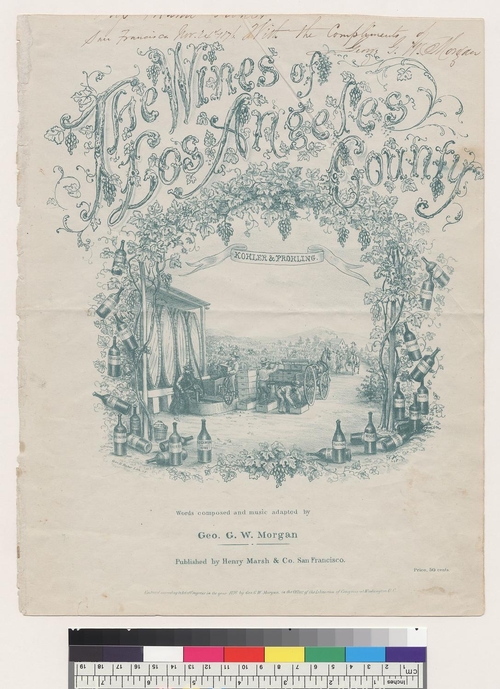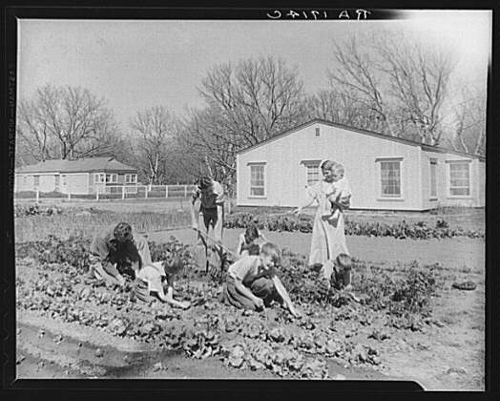- Author: Judi Gerber
Part Two: Commercial Winemaking Explodes in Los Angeles(1850s – 1860s)
As I wrote in Part 1, Los Angeles attracted wine growers in the early 1830s and 1840s and by the mid-1850s, there were over 100 wineries in the Los Angeles area, with at least seventy-five within the town itself (Carosso, 1951).
In fact, the 1850 United States Census indicates that there were 57,355 gallons of wine produced in Los Angeles County and in 1851 there were 104 vineyards in Los Angeles County (excluding San Gabriel) with all but 20 within the limits of the city of Los Angeles (McGroatry, 1923).
As the area along the Los Angeles River continued to be populated by vineyards and as prime locations on the river began to fill up, settlers looked for other locations.
The east side of the Los Angeles River was the first logical place for them to go. The first foreigner to make a major investment there was Irish-born Andrew A. Boyle, who came to America in 1832, and lived in New Orleans, Texas, San Francisco, and finally, Los Angeles.
In 1858, Boyle bought some land and a vineyard from Jose Rubio who had planted it in 1835 running right along the east side of the Los Angeles River under the bluffs (Historical Society of Southern California, 1901).
The area along the eastern bank of the LA River was known as Paredon Blanco (White Bluffs) and was still within Pueblo boundaries. Today, it is known as Boyle Heights and was actually named after Andrew Boyle. While others thought the land he bought was unsuitable, he built a home there, the first brick house east of the river, and he became the first white man to live east of the LA River in what is known as “the flats.”
He started making wine in 1862, and was the first to grow zinfandel grapes there and started to sell his wine under the Paredon Blanco name. He was also a member of the Los Angeles City Council during the 1860s.
In 1851, another Irish immigrant, Matthew Keller, opened a general merchandise store at the corner of Los Angeles and Commercial Streets. He soon joined Vignes and Wolfskill in growing wine grapes after purchasing property on Alameda and Aliso Street, at present-day Union Station. During the time, they were three of the most successful winemakers.
Keller added hundreds of acres to his land holdings when he bought 13,300 acres of the Rancho Topanga Malibu Sequit above Santa Monica in 1857, which he named the Rising Sun Vineyard.
Like Vignes, he also imported new varieties, and like Vignes, was known as “Don” Mateo (Spanish for Matthew). Present-day Mateo Street is named after him.
Today, there’s also a trail named in honor of Keller’s Winery: the Rising Sun Trail in Solstice Canyon in Santa Monica.
As the county grew and more and more people settled here, vineyards were started in areas east of El Pueblo, especially in present-day San Gabriel Valley. From the 1850s through the 1880s thousands of acres of grapes were planted there.
This included those planted by English immigrant William Workman, and his partner John Rowland, who planted vineyards at their La Puente Ranch in the 1840s and Hugo Reid, a Scotsman, who put in a vineyard in 1839 at his Rancho Santa Anita (today part of the Los Angeles County Arboretum) in present-day San Gabriel Valley and made wine there until he sold the property in 1846.
In 1854, German immigrants Kohler and Frohling established one of California’s largest winemaking businesses. They had a large vineyard in Los Angeles with a main cellar in San Francisco.
Charles Kohler was a violinist who had eventually settled in San Francisco to found the Germania Concert Society. John Frohling was a flutist in that orchestra. Legend has it that they were inspired to start a winery after eating some Los Angeles grapes at a picnic despite having no knowledge of or skills in winemaking.
Aside from their own grapes, they bought those of Keller, Wolfskill, Workman, and Rowland and that’s what allowed them to grow so big and to overtake others in their production. And, they also grew a wide variety of grapes including Riesling, Muscat, Claret, Zinfandel, Burgundy, Sherry, Port and Angelica.
The partners are credited with bringing Los Angeles wines into large-scale commerce. It is estimated that they produced 50,000 to 175,000 gallons of wine per year. Like other influential vintners, today, there’s a street named in downtown Los Angeles for them, Kohler Street.
They took a prize for best wine in 1858 at the State Fair. And they brought in new varieties to Los Angeles, especially those for making port and sherry.
Kohler and Frohling also were the first to make shipments of wine to the east and by 1860, had shipped over $70,000 worth of wine out of California and had offices in New York City and Boston (Pinney, 1989).
The Sainsevain Brothers also began shipping their wines to New York City and in 1861, opened a New York City Branch. In 1857, they were the first California vintners to produce champagne-like sparkling wine.
Word of Los Angeles wines spread in 1852, when Los Angeles wines were tasted in New York at the American Institute. The Sainsevain Brothers received high marks for their white wines labeled under the Aliso label and also for their sparkling wines.
Kohler and Frohling also were responsible for encouraging a group of German and Austrian immigrants from San Francisco to band together and form the Los Angeles Vineyard Society.
In February 1857, the society was created with the purpose of buying, cultivating and eventually living on a parcel of land devoted to viticulture along the Los Angeles River. However, that plan did not work out and since the members were so eager to get going, they settled on property along the Santa Ana River instead, some 20 miles away from Los Angeles, and the Society wound up in Anaheim, planting mostly Mission grapes (Pinney, 1989).
By the end of the 1860s, more and more pueblo land was being cultivated for wine. By 1869, Los Angeles had established itself as California's wine center, and its 43 wineries were producing four million gallons of wine annually (Rasmussen, 2000).
Sources:
Carosso, Vincent P. (1951) The California Wine Industry: A Study of the Formative Years. Berkeley, CA: University of California Press.
Historical Society of Southern California, (1901) Los Angeles County Pioneers of Southern California, (volumes 5-6).
Los Angeles Times, L.A. Then and Now; Wine Industry Took Root on Olvera Street, by Cecilia Rasmussen, (May 28, 2000).
McGroarty, John Steven, (1923). History of Los Angeles County, Volume 1. Chicagoe and New York: The American Historical Society.
Pinney, Thomas (1989). A History of Wine in America: From the Beginnings to Prohibition. Berkeley: University of California Press.
Workman, Boyle, (1936). Boyle Workman’s The City That Grew. Los Angeles: Southland Publishing Company

- Author: Rachel A. Surls
If you follow urban gardening/agriculture issues, you may have heard about a disagreement that’s received quite a bit of attention. Folks are upset with the Dervaes family of Pasadena because they have trademarked the terms “Urban Homestead” and “Urban Homesteading”. This family has operated an impressive mini-farm in their yard for a number of years, and has a website that shares information on how to become self-sufficient by producing food around your home. They have recently sent letters to others who use the terms “Urban Homestead” and “Urban Homesteading” in blogs, on Facebook pages, and even book titles, asking them to remove these terms or provide attribution. This has not been well received, to say the least. The OC Weekly and the LA Times, among others, have covered this issue in detail.
Rather than rehash the debate, I want to share what may be a little known fact; that Los Angeles was home to a movement which was a precursor to present-day interest in urban sustainability.
The trend was called “Small Farm Homes”, or “Little Farms” and gained momentum in the 1920s, then continued full-force for several decades. As the population of Los Angeles County mushroomed, and real estate boomed in tandem with growth, subdivisions were developed with micro farming in mind. Many homes were constructed on lots of one half to three acres, and marketed as “small farm homes” to newcomers flocking to Los Angeles. Many were Midwestern farmers who no longer wanted large farms and cold weather, but didn’t quite want to give up their agricultural heritage. Others drawn to these new homes were city people, attracted by publicity campaigns touting Southern California’s abundant harvests and golden sunshine and hoping to try their hand at small-scale farming. The automobile helped to promote the popularity of small farms on the periphery of the city, as newly mobile Angelenos could now easily transport their harvest to local markets.
The Los Angeles Chamber of Commerce did much to promote this “little farm development” around Los Angeles County. According to the Chamber, it was possible to make a living on a small farm on the outskirts of the city. People might make a go of it farming, according to the Chamber, with vegetables, fruit trees, and at least 200 laying hens on two to five acres. These small family-run, home-based farms helped to feed the demand of the growing city. The number of farms of less than 3 acres in Los Angeles County increased substantially during the 1920s, with 1,334 recorded in the 1920 census, and 5,000 in the 1930 census (White, 1933).
The Chamber, in cooperation with the LA Times, ran an annual Small Farm Home contest, publishing photos and stories about the winners, with the following entry a typical example:
“The one-acre farm of C.E. Drummond, 15219 Stagg Street, in West Van Nuys, is another where beauty and utility have been successfully combined in the making of a rural home. Here, again, are flowers for joy and recreation, vegetables and fruits for the table, and chickens to help swell the family purse (Scarborough, 1930, p. K12).”
Small farm homes contributed significantly to Los Angeles County’s status as the number one agricultural county in the US during this era. They also helped to make Los Angeles food-secure. According to a 1940 Los Angeles Chamber of Commerce brochure, “nearly half of the Los Angeles food supply originates on farms within 50 miles of the city”.
The small farm home trend continued through the Depression and well into the 1950s. In 1949, the University of California reported there were approximately 10,000 families living on small farms of one acre in size or smaller in Los Angeles County.
There are certainly differences between yesterday’s small farm homes, and today’s urban homesteads (TM). Today’s urban and suburban lots are much smaller. The Dervaes family’s Pasadena home is on a 1/5 acre lot, and certainly, many urban dwellers have much less space. The harvest from an urban yard today is more likely to supplement a family’s diet and income, rather than constitute a main component. Still, the motivators for self-sufficiency today and eighty years ago are similar; good food, a little relief for the family budget, and a sense of pride in “growing your own.” Whether you call it an "urban homestead (TM)", or a "small farm home", or maybe just "planting a garden", it’s a Los Angeles tradition that is once again gaining momentum.
Sources:
Scarborough, O. (1930, Jan. 5, 1930). What acre offers. Los Angeles Times.
What the newcomer should know about agriculture in Los Angeles County and Southern California (1940). In L. A. C. C. o. Commerce (Ed.) (pp. 51). Los Angeles: Los Angeles County Board of Supervisors.
White, R. P. (1933, Jan. 3). The new city of country homes. Los Angeles Times.



